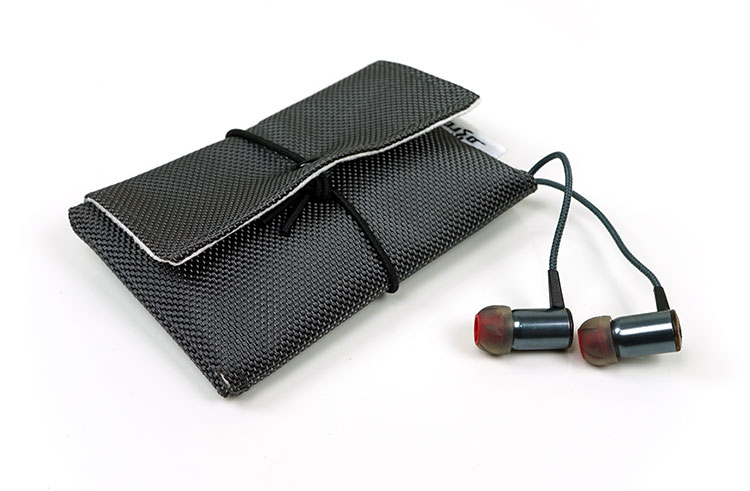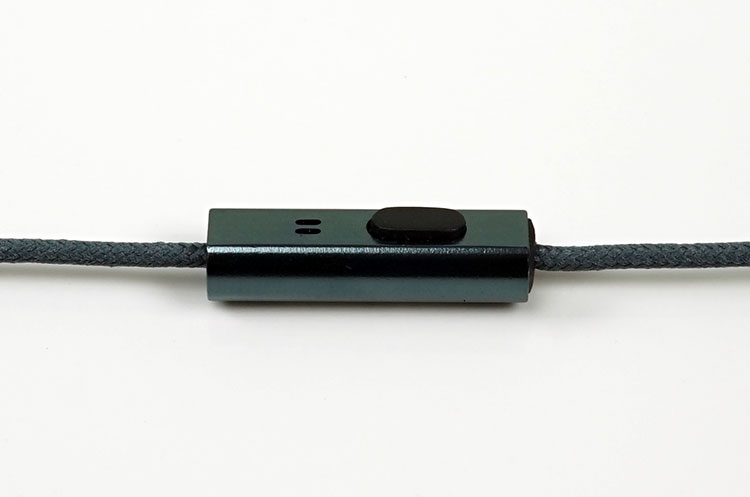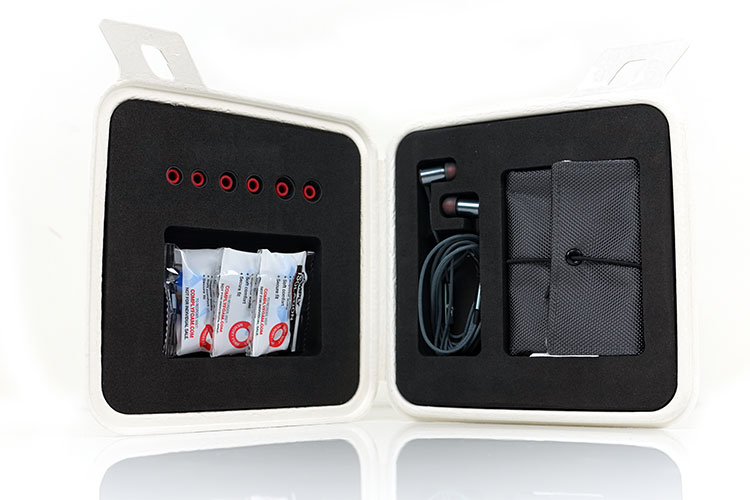The oBravo ERIB-7 is the company’s entry-level hybrid dynamic driver and planar tweeter universal monitor. It is priced at £249.
Disclaimer: The oBravo ERIB-7 sent to us is a sample in exchange for our honest opinion. We thank the team at oBravo and Audio Concierge for giving us this opportunity.
To read more about oBravo products we reviewed on Headfonics click here.
Note, this review follows our new scoring guidelines for 2020 which you can read up on here.
This is our fourth oBravo review in the last 3 years for us. This time we drop from the exotic $10k RA C-CU down to the more obtainable $300 marker with their new penultimate entry-level ERIB-7 (£249 inc. VAT).
This is a return to their hybrid dynamic driver and planar magnetic combination and not, as in the Ra and EAMT-2C, a hybrid AMT design.
The previous entry-level was the ERIB-5 back in early 2016 for closer to the $400 and I thought it was ok, perhaps a bit weirdly tuned and absolutely needed gobs of power too sound at its best in combination with the supplied foam tips.
It was an IEM, much like the Ra, that needs time to adjust and match to get it sounding just right.
On the surface not much has changed from the ERIB-5 save for a 1mm smaller dynamic driver but I do know oBravo always tinker with the sound.
This time around the ERIB-7 to my ear sounds a lot more “mainstream’ than the outlier sound of the ERIB-5. But like the ERIB-5 it needs a few adjustments to get it sounding optimal.
Technology Inside
The ERIB-7 is a dual driver hybrid monitor and one of 8 different IEMs in oBravo’s ERIB range, the other being their EAMT category. The ERIB range deploys planar and dynamic drivers whereas the EAMT series uses AMT drivers instead of planar.
Generally speaking, the EAMT range is the more expensive of the two hybrid tech designs. Going by the specs of the ERIB range, the common differentiator is nearly always the size of the neodymium driver inside each monitor. The smallest and cheapest is the ERIB-8 with a 6mm driver and the largest is the ERIB-1 series with a 12mm driver.
The ERIB-7 uses a single 7mm neodymium dynamic driver for the lows combined with an 8mm planar magnetic tweeter for the mids and highs. This is not a full-range planar IEM like the Audeze iSINE range but rather a coaxial design with a mix of planar and dynamic driver characteristics in its presentation.
Build Quality
Form Factor
The ERIB-7, much like the older ERIB-5 is an understated but well-built bullet-type form factor. Comprising of a mix of aluminum fixed lead alloy for the enclosure and topped by a woody top-plate it is elegant and professional looking as well as pretty sturdy in the hand.
It also weighs in at 35g which is the same as the ERIB-5 even though volumetrically these seem a little smaller than the ERIB-5.
Unlike the more expensive ERIB-5, the ERIB-7 is not a detachable cable design so you are stuck with the stock cable albeit at a cheaper price. This is a form factor that can be worn over the ear or straight down depending on your preferences. It is also a form factor that places a fairly strong emphasis on the type of tips you use for both sound characteristics and getting a good seal.
The ERIB-7 still uses a venting system on the woody top-plate but unlike the ERIB-5 there is a single venting port in the middle as opposed to 8 on the higher up models’ woody plate finish. Mind you not all of those holes on the ERIB-5 are porous according to oBravo so the ERIB-5 is more semi-open in nature but not wide open like an iSINE.
Cable
Options
The non-detachable aspect means you can only use the ERIB-7 in an unbalanced format since the cable is a 3.5mm TRS gold-plated jack termination. Comparing this with the supplied detachable cables from the high oBravo monitor line-up it does seem to be the same cable so you are not really missing out by being stuck with a cheaper cable.
You do however lose the option to go balanced with oBravo’s optional balanced cable which I feel would have been a nice option as stock. A balanced cable terminated with a 2.5mm and an optional 3.5mm or 4.4mm piggy-tail converter would have been a perfect addition.
Materials
The stock cable is a 4-wire OFC 1.2m in length with a grey cloth jacket. It is actually very light and definitely not prone to any memory retention and remained very tangle free during our time testing the ERIB-7.
As mentioned, this can be worn straight down or over the ear but I recommend over the ear to reduce the level of microphonics substantially. With the cable over the ear the level of physical noise on the wire is still slightly present but not a deal breaker.
Inline Controls
With the ERIB-7 you also get an in-line remote control and mic on the right side for playback and voice control for smartphones. A long press will also bring up Google voice controls. I had no issues working this off a Huawei P20 (dongle) or an LG G6 (jack) for playback control and Google.
For DAPs tested it also had no issues with controlling the FiiO Music app on the X5iii and the HiBy Music app on the Onkyo Granbeat. I could not get any controls on the new HiBy Music R6 Pro or the older R6 so I presume these two DAPs are not set up for this despite their Android platforms and use of the HiBy Music app.
Comfort & Fit
Bullet-type form factors are generally very easy on the ear for comfort and the ERIB-7 is no exception. With the lack of detachable cable, the older long and very stiff stem of the ERIB-5A is now gone allowing for a nicer over the ear experience than before. In its place is a smaller lightweight plastic stem that is generally much comfier if you like a deeper insertion. You will not find any awkward pressure on your outer ear.
Tips
The ERIB-7 comes supplied with two types of tips. A single bore silicone reddish tip in small, medium and large and a set of individually wrapped T-500 Comply tips in the same range of sizes.
The foam tips have a slight edge in terms of seal compared to the silicone tips. However, the gap is not as big as I figured it might be. Most likely this is down to the deeper insertion I can achieve with the silicone tips with that bullet-type form factor of the ERIB-7. Switching to some 3rd party tips and I found the Symbio (non-wide) single bore hybrid tips to offer possibly the best seal of the three tried though again the results are marginal.
Performance
What I can tell you is the silicone tips delivers a poor performance with the ERIB-7. They suck out what bass there is, and there is not that much sub-100Hz and give you a strange midrange to treble bias that does not sound right at all. I would suggest oBravo simply stop using silicone tips because in all of their IEM’s to date I have tried these tend to mess up the sound.
The foams balance it out much better with a thicker warmer timbre and better low-end presence. However, the Symbio tips nailed the sub-to-midbass definition the best for me and retained a little more air at the top-end compared to the foams.
Accessories & Packaging
The ERIB-7 uses a stripped-down RA C-CU style packaging material and more than anything I am thinking the ‘chippy’ shop container when I see it. I do know it is biodegradable with a reformed cardboard material so that’s brownie points for the environmental angle. Truth be told the inside layout is really quite nice and a big step up on the old ERIB-5 ‘fake wood grain’ box.
Inside everything is neatly laid out on each side of the fold out box in foam cut-aways. The accessory list is also pretty good though not on the level of their flagships obviously. You get the silicone and Comply T-500 foam tips on the one side and in the other the ERIB-7 monitors themselves and the little soft carry wrap we first saw with the ERIB-5. The case looks appealing and svelte though offering little in the way of protection against the elements or knocks. One for your pocket shall we say.
Click on Page 2 for Sound Impressions & Comparisons







